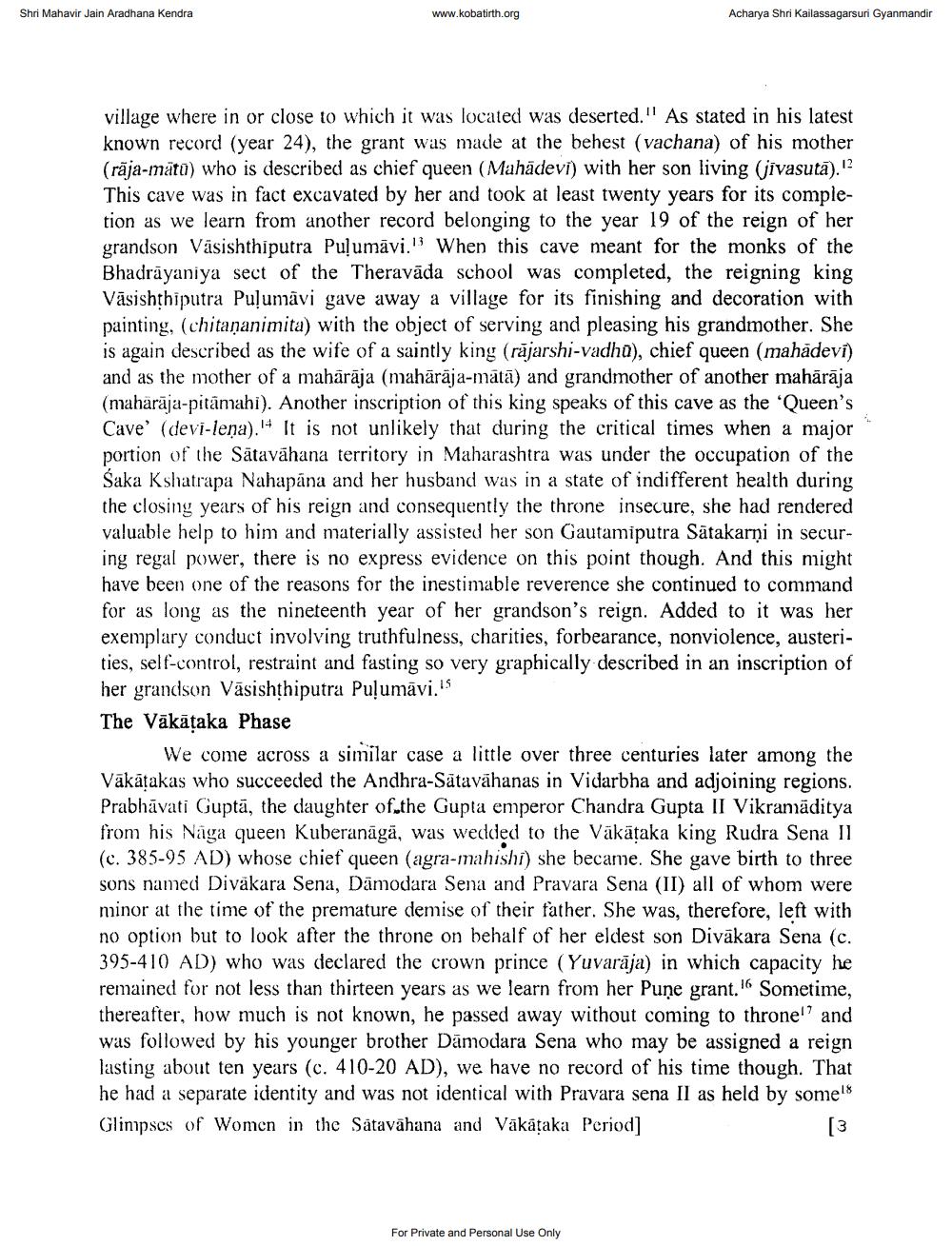________________
Shri Mahavir Jain Aradhana Kendra
www.kobatirth.org
Acharya Shri Kailassagarsuri Gyanmandir
village where in or close to which it was located was deserted." As stated in his latest known record (year 24), the grant was made at the behest (vachana) of his mother (rāja-mäta) who is described as chief queen (Mahādevi) with her son living (jivasuta). This cave was in fact excavated by her and took at least twenty years for its completion as we learn from another record belonging to the year 19 of the reign of her grandson Väsishthiputra Puļumāvi.! When this cave meant for the monks of the Bhadrāyaniya sect of the Theravāda school was completed, the reigning king Vāsishthiputra Puļumāvi gave away a village for its finishing and decoration with painting, (chitananimita) with the object of serving and pleasing his grandmother. She is again described as the wife of a saintly king (rājarshi-vadhū), chief queen (mahadevi) and as the mother of a mahārāja (mahārāja-mātā) and grandmother of another mahārāja (mahärāja-pitámahi). Another inscription of this king speaks of this cave as the 'Queen's Cave' (devi-lena).'+ It is not unlikely that during the critical times when a major portion of the Sātavāhana territory in Maharashtra was under the occupation of the Śaka Kshatrapa Nahapana and her husband was in a state of indifferent health during the closing years of his reign and consequently the throne insecure, she had rendered valuable help to him and materially assisted her son Gautamiputra Satakarni in securing regal power, there is no express evidence on this point though. And this might have been one of the reasons for the inestimable reverence she continued to command for as long as the nineteenth year of her grandson's reign. Added to it was her exemplary conduct involving truthfulness, charities, forbearance, nonviolence, austerities, self-control, restraint and fasting so very graphically described in an inscription of her grandson Vāsishthiputra Puļumāvi.is The Vākātaka Phase
We come across a similar case a little over three centuries later among the Vākātakas who succeeded the Andhra-Sātavāhanas in Vidarbha and adjoining regions. Prabhāvati Guptā, the daughter of the Gupta emperor Chandra Gupta II Vikramaditya from his Nāga queen Kuberanāgā, was wedded to the Vākātaka king Rudra Sena 11 (c. 385-95 AD) whose chief queen (agra-mahishi) she became. She gave birth to three sons named Divakara Sena, Damodara Sena and Pravara Sena (II) all of whom were minor at the time of the premature demise of their father. She was, therefore, left with no option but to look after the throne on behalf of her eldest son Divākara Sena (c. 395-410 AD) who was declared the crown prince (Yuvarāja) in which capacity he remained for not less than thirteen years as we learn from her Pune grant.16 Sometime, thereafter, how much is not known, he passed away without coming to thronel and was followed by his younger brother Damodara Sena who may be assigned a reign lasting about ten years (c. 410-20 AD), we have no record of his time though. That he had a separate identity and was not identical with Pravara sena II as held by somel Glimpses of Women in the Sātavāhana and Vākātaka Period]
[3
For Private and Personal Use Only




